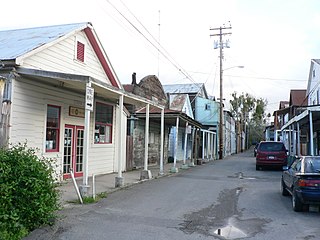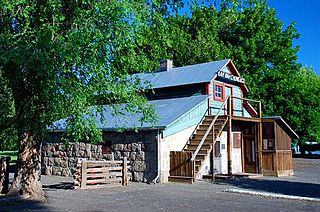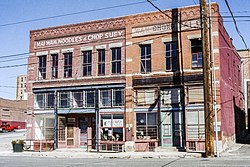
Butte is a consolidated city-county and the county seat of Silver Bow County, Montana, United States. In 1977, the city and county governments consolidated to form the sole entity of Butte-Silver Bow. The city covers 718 square miles (1,860 km2), and, according to the 2020 census, has a population of 34,494, making it Montana's fifth largest city. It is served by Bert Mooney Airport with airport code BTM.

The Chinatown–International District of Seattle, Washington is the center of the city's Asian American community. Within the district are the three neighborhoods known as Chinatown, Japantown and Little Saigon, named for the concentration of businesses owned by people of Chinese, Japanese and Vietnamese descent, respectively. The geographic area also once included Manilatown.

Locke, also known as Locke Historic District, is an unincorporated community in the Sacramento–San Joaquin River Delta of California, United States. The 14-acre town (5.7 ha) was first developed between 1893 and 1915 approximately one mile north of the town of Walnut Grove in Sacramento County.

This is a list of properties and historic districts in Montana that are listed on the National Register of Historic Places. The state's more than 1,100 listings are distributed across all of its 56 counties.
The Chinese Consolidated Benevolent Association (CCBA) is a historical Chinese association established in various parts of the United States and Canada, with large Chinese communities. It is also known by other names, such as Chinese Six Companies in San Francisco, especially when it began, in the 19th century; Chong Wa Benevolent Association in Seattle, Washington; and United Chinese Society in Honolulu, Hawaii. The association's clientele were Chinese immigrants of the late 19th and early 20th centuries, who came mainly from eight districts on the west side of the Pearl River Delta in Guangdong, southern China, and their descendants. The latter wave of Chinese immigrants, after 1965, who came from a much wider area of China, did not experience the level of hostilities faced by the pioneers and did not join the CCBA, which greatly lessened its influence.

Garnet is a ghost town in Granite County, Montana, United States. Located on the dirt Garnet Range Road, it is an abandoned mining town that dates from the 1860s. In First Chance Gulch in western Montana, the town is located 11 miles up the Garnet Range Road, in mountains and forest. The town is at approximately 6,000 feet (1,800 m) elevation.

The East Kong Yick Building is one of two buildings erected in Seattle, Washington's Chinatown-International District (ID) by the Kong Yick Investment Company. A four-story hotel in the core of the ID, with retail stores at ground level, the East Kong Yick was created by the pooled resources of 170 Chinese American pioneers. In, 2008, the building reopened as the home of the expanded Wing Luke Asian Museum.

The Kam Wah Chung & Co. Museum, also known as Kam Wah Chung Company Building, is a state park and a National Historic Landmark that preserves early Chinese culture in John Day in the U.S. state of Oregon. Built in the 1865 by George Hazeltine as a supply depot or stagecoach stop along the Dalles-Canyon City wagon road., it is the best-preserved example of a Chinese herbal apothecary and mercantile establishment dating to the post-Civil War period of growth in the Western United States.

The Butte–Anaconda Historic District is a National Historic Landmark (NHL) that spans parts of Walkerville, Butte and Anaconda, Montana, United States. It has the most resources of any U.S. National Historic Landmark District.

The Chinese Historical Society of America is the oldest and largest archive and history center documenting the Chinese American experience in the United States. It is based in the Chinatown neighborhood of San Francisco, California.

The Chinatown Historic District is a neighborhood of Honolulu, Hawaii, known for its Chinese American community. It is one of the oldest Chinatowns in the United States.

Chinatowns are enclaves of Chinese people outside of China. The first Chinatown in the United States was San Francisco's Chinatown in 1848, and many other Chinatowns were established in the 19th century by the Chinese diaspora on the West Coast. By 1875, Chinatowns had emerged in eastern cities such as New York City, Boston, and Philadelphia. The Chinese Exclusion Act of 1882 barred Chinese immigration to the United States, but the Magnuson Act of 1943 repealed it, and the population of Chinatowns began to rise again. In the 2010s, the downturn in the U.S. economy caused many Chinese Americans to return to China.

The Temple of Kwan Tai is a Chinese Taoist temple in Mendocino, California, dedicated to Kwan Tai. It is California Historical Landmark #927.

The Bozeman Carnegie Library in Bozeman, Montana was built in 1903–1904 with funding from Andrew Carnegie. City librarian Bell Chrisman led the effort to convince the city to seek Carnegie funds. It is one of 17 libraries in Montana and 1,679 in the United States funded by Carnegie. It was built on a Greek Cross plan in Classical Revival style, with Roman Doric columns supporting a triangular pediment at its entrance. The library was listed on the National Register of Historic Places on February 2, 1979. Today, the building houses the law offices of Cok Kinzler, PLLP.

The Taoist Temple at No. 12 China Alley in Hanford, in Kings County, California, dates from 1893. It was listed on the U.S. National Register of Historic Places (NRHP) in 1972.

The Dumas Brothel was a brothel in Butte, Montana. The brothel was founded by French-Canadian brothers Joseph and Arthur Nadeau in 1890 and named after the nominal owner, Delia Nadeau, née Dumas, who was Joseph's wife. It grew considerably through the years, with the miners employed by the city's copper mines often patronizing the establishment. After several changes of the "madams" and continuing pressure from authorities, the brothel closed in 1982, described as "a rare, intact commentary on social history". At the time of its closure, it was the longest operating brothel in the United States, having operated years after prostitution was made illegal. After closing, the brothel changed hands several times, eventually becoming a tourist attraction owned and managed by a series of Butte residents.

Butte is a city in southwestern Montana established as a mining camp in the 1860s in the northern Rocky Mountains straddling the Continental Divide. Butte became a hotbed for silver and gold mining in its early stages, and grew exponentially upon the advent of electricity in the late-nineteenth century due to the land's large natural stores of copper. In 1888 alone, mining operations in Butte had generated an output of $23 million. The arrival of several magnates in the area around this time, later known as the "Copper Kings," marked the beginning of Butte's establishment as a boomtown.

Pekin Noodle Parlor is the oldest continuously operating Chinese restaurant in the United States, located in Butte, Montana. The restaurant was founded in its current location in 1911 by Hum Yow and Tam Kwong Yee. Along with the Wah Chong Tai Company mercantile building (1891) and the Mai Wah Noodle Parlor (1909), the Pekin Noodle Parlor represents one of the last surviving properties from the original Chinatown neighborhood in the Butte–Anaconda Historic District.




















